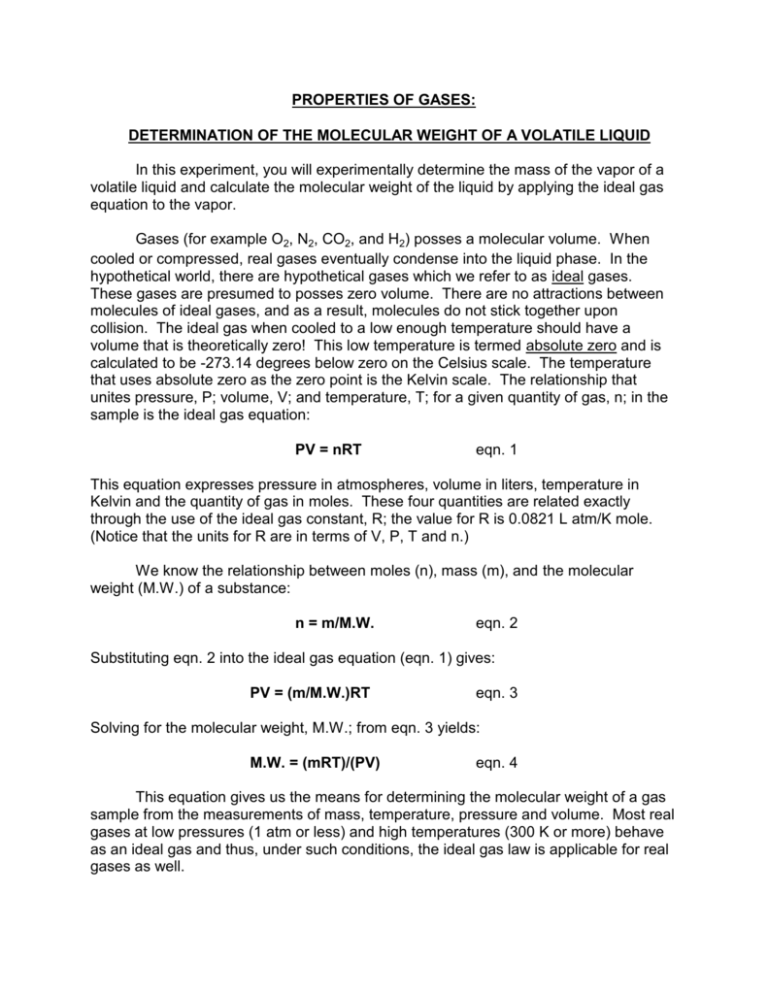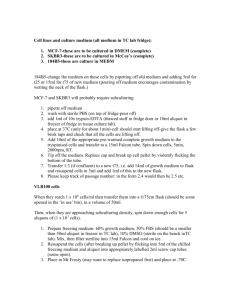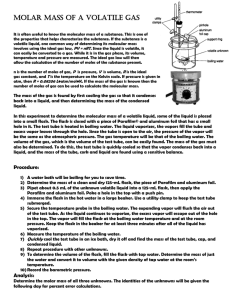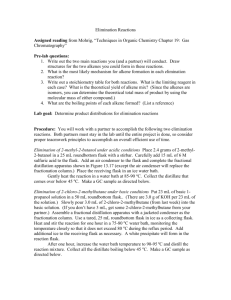Molar Mass of a Volatile Liquid Post Lab
advertisement

PROPERTIES OF GASES: DETERMINATION OF THE MOLECULAR WEIGHT OF A VOLATILE LIQUID In this experiment, you will experimentally determine the mass of the vapor of a volatile liquid and calculate the molecular weight of the liquid by applying the ideal gas equation to the vapor. Gases (for example O2, N2, CO2, and H2) posses a molecular volume. When cooled or compressed, real gases eventually condense into the liquid phase. In the hypothetical world, there are hypothetical gases which we refer to as ideal gases. These gases are presumed to posses zero volume. There are no attractions between molecules of ideal gases, and as a result, molecules do not stick together upon collision. The ideal gas when cooled to a low enough temperature should have a volume that is theoretically zero! This low temperature is termed absolute zero and is calculated to be -273.14 degrees below zero on the Celsius scale. The temperature that uses absolute zero as the zero point is the Kelvin scale. The relationship that unites pressure, P; volume, V; and temperature, T; for a given quantity of gas, n; in the sample is the ideal gas equation: PV = nRT eqn. 1 This equation expresses pressure in atmospheres, volume in liters, temperature in Kelvin and the quantity of gas in moles. These four quantities are related exactly through the use of the ideal gas constant, R; the value for R is 0.0821 L atm/K mole. (Notice that the units for R are in terms of V, P, T and n.) We know the relationship between moles (n), mass (m), and the molecular weight (M.W.) of a substance: n = m/M.W. eqn. 2 Substituting eqn. 2 into the ideal gas equation (eqn. 1) gives: PV = (m/M.W.)RT eqn. 3 Solving for the molecular weight, M.W.; from eqn. 3 yields: M.W. = (mRT)/(PV) eqn. 4 This equation gives us the means for determining the molecular weight of a gas sample from the measurements of mass, temperature, pressure and volume. Most real gases at low pressures (1 atm or less) and high temperatures (300 K or more) behave as an ideal gas and thus, under such conditions, the ideal gas law is applicable for real gases as well. For this experiment, a small quantity of a volatile liquid will be placed in a preweighed flask. Since the boiling point of the liquid will be below that of boiling water, when the flask is submerged in a boiling water bath the liquid will vaporize completely, i.e., be turned into a gas. This gas will drive out the air in the flask and fill the flask with the gaseous sample. The gas pressure in the flask is in equilibrium with atmospheric pressure and, therefore, can be assumed equal to it. This pressure is obtained from a barometer which is used to measure atmospheric pressure. The temperature of the gas is also the same as the temperature of the boiling water. Cooling the flask condenses the vapor back to a liquid and thus the mass of the vapor is the same as this liquid. This can be determined by weighing the flask with the condensed liquid and subtracting out the mass of the empty flask. In order to determine the volume of the flask, we fill the flask with water and weigh it. The water fills the same volume as the vapor, so by finding the mass of this water (How would you do that?) and using the density of water (0.9969 g/mL) you can calculate the volume of the flask. EXAMPLE: An Erlenmeyer flask that weighs 93.667g has a quantity of liquid vaporized in it o at 98.4 C and a pressure of 769.8 torr. The mass of the cooled flask is 94.032g. When the flask is filled with water, the mass of the flask and water is 241.92g. Determine the molecular weight of the unknown liquid. The mass of the condensed vapor is 0.365g. The volume of the flask is the mass of water in the flask divided by the density of water and thus the flask has a volume of 148.7mL. We need to convert the volume into liters, temperature into Kelvins and pressure into atmospheres. After doing this we can use eqn. 4 to calculate the molecular weight of this chemical. [(0.365 g)(0.0821 L atm/K mole)(371 K)] M.W. = [(1.013 atm)(0.1487 L)] or M.W. = 73.8 g/mole Pentane, with a molecular weight of 72.2 g/mole is the closest match for the unknown. EXPERIMENTAL PROCEDURE: Take a 1000 mL beaker and add 900 mL of water and 2 boiling chips. (The boiling chips allow for smooth boiling). Heat the water to boiling using a hot plate. A hot plate is recommended and not a Bunsen burner since the unknown liquids used in this experiment are flammable. While your water is heating, obtain a sample of unknown liquid from your instructor and record the code of your unknown. The unknown liquid will be one of the liquids found in the table below. Volatile Liquid Unknowns Liquid Pentane Acetone Methanol Hexane Ethanol Propanol Molecular Weight (g/mole) 72.2 58.1 32.0 86.2 46.1 60.1 Obtain a 125 mL Erlenmeyer flask. You may assume this flask is clean and dry and therefor need not wash it. All together weigh this flask along with a 12.5 cm by 12.5 cm square of aluminum foil and a rubber band. Record the total mass to the nearest 0.001 g. Pour all of your liquid into the flask. Cover the mouth of the flask with the aluminum foil square and crimp the edges tightly over the neck of the flask. Secure the foil by wrapping the rubber band around the neck. Have this checked by your instructor. With a second square of 12.5 cm by 12.5 cm aluminum foil, secure (with a rubber band) a cover for the first piece of aluminum foil and rubber band. This additional cover is to prevent the first piece of foil and rubber band from getting wet. Carefully punch a single small hole in the foil covers with a needle or pin (see fig. 1). After attaching the neck of the flask to a clamp, attach the clamp to a ring stand, making sure that the flask is tilted. The assembly is now ready for heating. Immerse the flask containing the volatile unknown liquid in the boiling water so that most of the flask is beneath the boiling water (see fig. 2). Observe the unknown liquid. There is more liquid than is required to fill the flask with vapor. As the liquid evaporates, its level will decrease and excess vapor will escape through the pin hole. When all the liquid in the flask appears to be gone, remove the flask and record the o temperature of the boiling water (to the nearest 0.1 C), which as you might guess, is the same temperature as the vapor in the flask. When the flask has cooled to room temperature, wipe dry the outside of the flask with a paper towel. Carefully remove only the second outer foil cover and blot dry the first foil cover with a paper towel. There should be liquid present in the flask. Weigh the flask, foil cover, rubber band and the condensed liquid. Record this mass to the nearest 0.001 g. Remove the foil cover and rubber band from the flask but do not discard them. Rinse the flask with water and refill with water to the rim. Wipe dry the outside of the flask and weigh the flask with the water, foil and rubber band to the nearest 0.01g on a centigram balance. During this experiment, your instructor will determine the barometric pressure in the lab. Return your boiling chips to the used boiling chips container. REPORT SHEET: MOLECULAR WEIGHT OF A VOLATILE LIQUID Name: Lab Partner: A) Vapor Collection Data: 1. Unknown Code: 2. Mass of cooled flask, aluminum foil, rubber band, and condensed liquid: 3. Mass of dry flask, foil and rubber band: 4. Mass of condensed liquid: 5. Mass of vapor: 6. Temperature of boiling water (in oC) when liquid is completely vaporized: 7. Temperature of vapor in flask (in oC): 8. Atmospheric Pressure in mm Hg: B) Flask Volume Data: 1. Mass of flask, foil, rubber band, and water: 2. Mass of dry flask, foil and rubber band: 3. Mass of water in flask: 4. Volume of water in mL ( dwater = 0.9969g/mL): (show your work) 5. Volume of flask in mL: C) Calculations: 1. Temperature of vapor in Kelvin: (show your work) 2. Atmospheric Pressure in Atm. : (show your work) 3. Volume of flask in Liters: 4. Molecular Weight of the Unknown: (show your work) What is the identity of your unknown liquid? Explain. Post Laboratory Questions 1) For each of the following situations, explain in what way the experimentally determined molecular weight would differ from the actual molecular weight. a) You neglect to dry the outside of the flask after you have vaporized your unknown liquid. b) You assume atmospheric pressure is exactly 1 atmosphere. 2) If you filled your flask with liquid carbon tetrachloride (d = 1.59 g/mL) rather than water, what would be its mass? Show your work. Post Laboratory Questions 1) For each of the following situations, explain in what way the experimentally determined molecular weight would differ from the actual molecular weight. a) You assume the volume of the flask is 125 mL. b) All of the unknown liquid does not vaporize. 2) If you filled your flask with liquid diethyl ether (d = 0.713 g/mL) rather than water, what would be its mass? Show your work. Post Laboratory Questions 1) For each of the following situations, explain in what way the experimentally determined molecular weight would differ from the actual molecular weight. a) Your thermometer is miscalibrated and always reads 3oC lower than the actual temperature. b) The aluminum foil is not flat across the top of the flask, but instead protrudes into the flask. 2) If you filled your flask with liquid carbon disulfide (d = 1.26 g/mL) rather than water, what would be its mass? Show your work.








